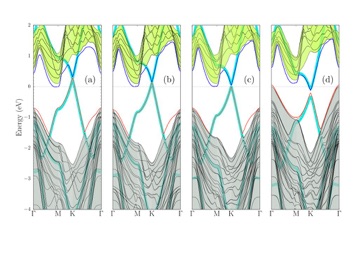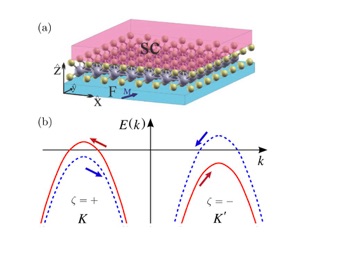


Research Highlights

One of our research directions is to explore ways of engineering superconducting correlations in proximized systems with the aim to obtain exotic pairings.
As an example we believe spin-triplet pairing can be engineered in single atomic-layers of transition-metal dichalcogenides (TMDCs). These are very special materials with very rich physics ranging from Dirac like spectrum and strong spin-orbit interactions (SOI) to correlated phase like superconductivity (SC) and charge density wave. We have shown that when an external spin splitting field is present, a variety of superconducting order parameters can emerge from the interplay of SOI, magnetism and SC. Interestingly, we find that the entire spectrum of possibilities for the induced pairing amplitudes is covered; to be symmetric or antisymmetric with respect to the valley and spin degrees of freedom, as well as even or odd in frequency. Specifically, both spin-singlet and triplet pairings between electrons from the same and opposite valleys arise due to the combined effects of intrinsic spin-orbit coupling and a magnetic-substrate-induced exchange field. As a key finding, we reveal the existence of an exotic even-frequency triplet pairing between equal-spin electrons from different valleys, which arises whenever the spin orientations in the two valleys are noncollinear. All types of superconducting order turn out to be highly tunable via straightforward manipulation of the external exchange field.
In another previous investigation, we had revealed that p-doped semiconductors at the proximity of a conventional superconductor can host a combination of s-wave and d-wave correlations. Moreover since the effective low energy properties of this system is usually described by spin-3/2 quasiparticles and the so-called Luttinger Hamiltonian, the superconducting pairing function is not limited to singlet and triplet one and can have higher spin components of Cooper pairing. These pairings are called as septet or quintet and recently these type of pairing have been observed in in some half-Heusler compounds which turn to be topological semimetals and undergo a superconducting transition.
(a) A TMDC single-layer sandwiched between a SC material and in a proximity with a magnetic insulator to induce spin-splitting. (b) The valence sub-bands at two valleys at the presence of SOI and externally induced spin-splitting. Arrows show the spin orientation of corresponding eigenstates.
Band structures of silicene supported on a halogenated Si(111) surface. (a)–(d) correspond to fluorine-, chlorine-, bromine-, and iodine-passivated substrates. Cyan circles show the Wannier-interpolated bands obtained by an unconstrained projection onto atomic orbitals of silicene.
One of our research directions is to explore various features ranging from the band structures to quantum transport in topological insulating and superconducting phases.
In two dimensions, one of the acclaimed topological insulators is silicene, which is nothing but a single-layer of silicon. Despite its many similarities to graphene presence of spin-orbit interaction leads to topological insulating phase at low energies. Nevertheless the topological gap of silicene is tiny which puts strong limitations on exploring topological aspects of silicene. Using exhaustive first principle calculations based on density functional theory we predicted that presence of haloganted silicon substrate underneath the silicene could leads to larger gap while keeping the low energy effective properties especially the non-trivial topology of the system unaffected.
Moreover, employing non-equilibrium Green’s function techniques transport properties of a zigzag silicene ribbon in the presence of magnetic impurities has been investigated in our group couples of years ago. We find that although time-reversal symmetry is already broken with a negligible amount of magnetic impurities, however when their concentration is low, the edge currents are not significantly affected. In this case, when the exchange field lies in the x–y plane, the spin mixing around magnetic impurity is more profound rather than the case in which the exchange field is directed along the z-axis. In addition, when the exchange field of magnetic impurities is placed in the x–y plane, a spin-polarized conductance is observed which can be promising for spintronic applications of silicene doped with magnetic impurities.
Engineering superconducting states in two-dimensional systems
Phys Rev. B 95, 104515 (2017); Phys Rev. B 89, 184507 (2014); Physica C 548, 123 (2018)
Topological aspects of two-dimensional systems
Phys Rev. B 97, 125301 (2018); Superlattices Microstruct. 100, 214 (2016); J. Phys. D: Appl. Phys. 49, 355001 (2016)
Spintronics and spin transport with graphene
Phys. Rev. Lett. 105, 146803 (2010); J. Phys. D: Appl. Phys. 48, 295004 (2014); Phys Rev. B 91, 155407 (2015)
Top panels show the Seebeck coefficients corresponding to charge (left) and spin (right). Both coefficients are highly tunable by varying chemical potential. Bottom left panel: local spin density of states and local spin current density (projected in the x-y plane) around the image point of the graphene-based spin lens. Bottom right panel: Pumped spin current variation with the fermi level of normal and magnetic graphene region.
Collaborations:
Alireza Akbari
APCTP & POSTECH, Pohang, SOUTH KOREA
Saeed Abedinpour
IASBS, Zanjan, IRAN
Habib Rostami
Nordita, Stockholm, SWEDEN
Fariborz Parzgar
University of Uppsala, Uppsala, SWEDEN
Michele Governale & Uli Zuelicke
Victoria University of Wellington, NEW ZEALAND
Jürgen König
Duisburg-Essen Universität, GERMANY
Reza Asgari
IPM, Tehran, IRAN
Alireza Qaiumzadeh
NTNU, Trondheim, NORWAY
The ultimate goal and simultaneously the main challenge of spintronics is the generation and sensing of pure spin currents. During the last few decades, several ways have been proposed and implemented to generate spin current such as electrical spin injection, optical methods and spin hall effect. Both theory and experiment have revealed that two dimensional carbon lattice i.e. graphene and other related systems can be promising for spintronics applications. The main advantages of these materials rely on their huge controllability as well as very long spin relaxation times inside them. We have tried out various methods for generating strong spin currents in graphene who has the 2D materials flagship. The first method we suggested was based on the Klein tunneling and negative refractive properties of graphene p-n junctions. So we suggest a magnetic graphene region (induced by proximity with a ferromagnetic insulator or applying large magnetic fields) with finite spin-splitting which succeeds the doping level can act as a “spin lens” which focus electronic waves injected locally from a normal graphene region in the other side of the magnetic part but only for a certain spin direction because of transition from conduction to valence band upon passing through magnetic graphene. In the second scenario, a dynamically excited ferromagnet at the proximity of a 2D material is used to adiabatically pump spins through the interface, giving rise to a pure spin current. The latest method which belongs to the so-called spin-caloritronics, exploits thermal excitations at the presence of spin polarization to generate pure spin currents.